Historic black towns: Preserving Communities of Color Conference, Nov. 16-20
Mayors and civic leaders from historically African-American communities will meet in Houston for a multi-day conference, pop-up classrooms, bus tours, round table discussions, workshops and interactive activities focused entirely on the needs of communities of color. The “Preserving Communities of Color Conference” is organized by the Texas branch of the Historic Black Towns and Settlements Alliance (HBTSA), and will be taking place at the Hilton Houston North hotel located at 12400 Greenspoint Dr., Houston, TX 77060 from Wednesday, November 16, through Sunday, November 20.
Day 2 of the conference will be held at PVAMU and include the opening of a new exhibit at the Texas Institute for the Preservation of History and Culture gallery in the School of Architecture. The exhibit will focus on the histories of all-black towns, referred to as freedmen towns and communities, founded after emancipation. More than 1,200 black settlements, enclaves, and towns were established in every state in the lower forty eight contiguous United States between the late eighteenth and early twentieth centuries. The history of many of those communities has not been well documented and these stories are rarely told, but leaders today are working together to ensure that heritage is preserved and celebrated.
According to Tanya Debose, conference committee chair and executive director of Houston’s Independence Heights neighborhood, founded in 1915 as the first black municipality in Texas, “This is a defining moment for people of color to come together and learn, share, and celebrate our contributions to the world.”
The conference will bring together more than 50 expert speakers and a multitude of resources available to help communities of color preserve their heritage, address challenges, and capitalize on opportunities. The aim of this event is to create a sustainable agenda for transforming historic communities of color into thriving places and cultural destinations, and to assure that the untold history of the African American experience in America is told.
For more information visit the conference website, or email, info@blacktownsandsettlements.org.
Millennials want something different from HBCUs — and they are getting it
 Social media, unique curricula and nurturing campuses lift enrollment at many schools
Social media, unique curricula and nurturing campuses lift enrollment at many schools
The statistics are eye-catching, and will draw double takes, for sure. Let’s start with Shaw University, at 49 percent; South Carolina State University, 39 percent; Tuskegee University, 32 percent; Virginia State University, 30 percent; Dillard University, 22 percent; Central State, 22 percent.
Those figures represent the percentage increases in freshman enrollment this fall at some historically black colleges and universities (HBCUs) from around the nation. So, what is the catalyst for this autumn acceleration?
Some have called it a sort of cool, in-style renaissance, reminiscent of the days when HBCUs were featured prominently in electronic media on such television shows as A Different World and The Cosby Show.
Others have cited the so-called “Missouri Effect.” (Read more of The Undefeated story here.)
Related: From The Root, “Promises and Compacts: What a Hillary Clinton Presidency Means for HBCUs“
Anderson High School closed 45 years ago, but East Austin still feels its absence
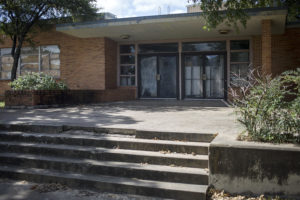
The entrance of the old Anderson High School. The school was closed in 1971 as part of desegregation efforts. Photo: Miguel Gutierrez Jr./KUT News
Many students and community members then, and now, think the closing of Austin’s Anderson High School in 1971 and the larger push for integration negatively affected the East Austin community into the 1970s and 1980s.
Former Anderson student Ambres Kearney says around the time Anderson closed, he noticed businesses begin to close along the once bustling 10th, 11th and 12th streets. Many of the buildings remained vacant, taxes went up and people stopped building. The community wasn’t gathering together the way it used to because students and families were scattered at schools across the city. That catalyst was gone.
“The schools were the foundation of the community,” says Brenda Mims Malik, who grew up in the neighborhood. “The schools and churches. And when we lost the ability to go to our neighborhood high school…we lost a lot of communal activity because of that closing.”
Listen to the broadcast and read the NPR story from Austin’s KUT here.
TIPHC Bookshelf
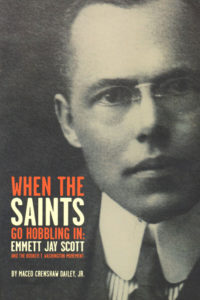 Published scholarship on black history in Texas is growing and we’d like to share with you some suggested readings, both current and past, from some of the preeminent history scholars in Texas and beyond. We invite you to take a look at our bookshelf page — including a featured selection — and check back as the list grows. A different selection will be featured each week. We welcome suggestions and reviews. This week, we offer, “When the Saints Go Hobbling In: Emmett Jay Scott and the Booker T. Washington Movement,” by Maceo Crenshaw Dailey, Jr.
Published scholarship on black history in Texas is growing and we’d like to share with you some suggested readings, both current and past, from some of the preeminent history scholars in Texas and beyond. We invite you to take a look at our bookshelf page — including a featured selection — and check back as the list grows. A different selection will be featured each week. We welcome suggestions and reviews. This week, we offer, “When the Saints Go Hobbling In: Emmett Jay Scott and the Booker T. Washington Movement,” by Maceo Crenshaw Dailey, Jr.
Challenging several of the commonly held views about Booker T. Washington and his followers, this collection of essays offers a new estimation of their accomplishments and successes as having been greater than previously recognized by historians. Criticized for his gradual approach and often called an accommodationist in his own time, Booker T. Washington’s influence on civil rights was nonetheless significant and his writing continues to educate on the efforts of post-Emancipation America. The book explores his connections with presidents, such as Theodore Roosevelt and Calvin Coolidge, and examines the issues of black entrepreneurship in both in the United States and Africa—providing guidance for today’s African American community to seek a way and means to deal with economic dislocation and despair. It also presents a thorough study of Washington’s secretary, Emmett Jay Scott, whose own influence as a leader continued well into the modern era through his familial connections to the Black Panther Party. This important collection will round out scholarly studies of Booker T. Washington and the movement he created with the fresh perspective it presents.
This Week In Texas Black History, Oct. 9-15
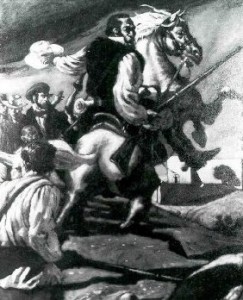 9 – On this day in 1835, Samuel McCullough, a free black man, participated in the first offensive action of the Texas Revolution, in Goliad, and is considered the war’s first casualty. McCullough was born on Oct. 11, 1810 in Abbeville, South Carolina and came to Texas with his father, who was white. McCullough joined the Matagorda Volunteer Company as a private and was severely wounded in the right shoulder during the Goliad confrontation as the Texans stormed the Mexican officers’ quarters. McCullough was the only Texan wounded in the battle.
9 – On this day in 1835, Samuel McCullough, a free black man, participated in the first offensive action of the Texas Revolution, in Goliad, and is considered the war’s first casualty. McCullough was born on Oct. 11, 1810 in Abbeville, South Carolina and came to Texas with his father, who was white. McCullough joined the Matagorda Volunteer Company as a private and was severely wounded in the right shoulder during the Goliad confrontation as the Texans stormed the Mexican officers’ quarters. McCullough was the only Texan wounded in the battle.
 10 – Singer and actress Teresa Graves died in a fire at her Hyde Park (Los Angeles) home on this day in 2002 at age 54. Graves, a Houston native, was a regular on ”Rowan & Martin’s Laugh-In” comedy show in 1969 and 1970. She also starred in the television police drama “Get Christie Love” in 1974-75, making her the first black actress to have her own hour-long dramatic TV series.
10 – Singer and actress Teresa Graves died in a fire at her Hyde Park (Los Angeles) home on this day in 2002 at age 54. Graves, a Houston native, was a regular on ”Rowan & Martin’s Laugh-In” comedy show in 1969 and 1970. She also starred in the television police drama “Get Christie Love” in 1974-75, making her the first black actress to have her own hour-long dramatic TV series.
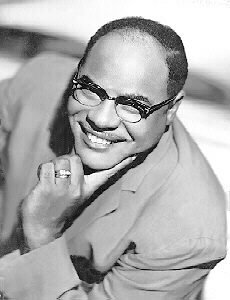 10 – On this day in 1914, Ivory Joe Hunter, R&B singer and songwriter was born in Kirbyville. Hunter was a teenager when he began touring as a musician. His first of several hit songs was “I Almost Lost My Mind,” which topped the R&B charts in 1950 and later that year “I Need You So” reached number 2. In 1957, “Since I Met You Baby” reached No. 1 and “Empty Arms” reached No. 2. Later in his career, he turned to country and western music and regularly appeared at the Grand Old Opry. A prolific songwriter, it’s estimated that Hunter penned more than 7,000 songs. Elvis Presley recorded two of Hunter’s songs that made the Top 20, “My Wish Came True” and “Ain’t That Loving You Baby.” And, in 1970, Sonny James cover of “Since I Met You Baby” was No. 1 on the country charts. Hunter is honored as a music legend in the Museum of the Gulf Coast’s Music Hall of Fame in Port Arthur. A Texas Historical Marker honoring Hunter was erected near Magnolia Springs in Jasper County in 2009.
10 – On this day in 1914, Ivory Joe Hunter, R&B singer and songwriter was born in Kirbyville. Hunter was a teenager when he began touring as a musician. His first of several hit songs was “I Almost Lost My Mind,” which topped the R&B charts in 1950 and later that year “I Need You So” reached number 2. In 1957, “Since I Met You Baby” reached No. 1 and “Empty Arms” reached No. 2. Later in his career, he turned to country and western music and regularly appeared at the Grand Old Opry. A prolific songwriter, it’s estimated that Hunter penned more than 7,000 songs. Elvis Presley recorded two of Hunter’s songs that made the Top 20, “My Wish Came True” and “Ain’t That Loving You Baby.” And, in 1970, Sonny James cover of “Since I Met You Baby” was No. 1 on the country charts. Hunter is honored as a music legend in the Museum of the Gulf Coast’s Music Hall of Fame in Port Arthur. A Texas Historical Marker honoring Hunter was erected near Magnolia Springs in Jasper County in 2009.
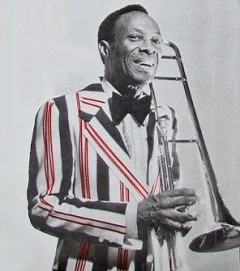 10 – Milt Larkin, bandleader and self-taught jazz trumpeter, was born on this day in 1910 in Navasota. Larkin began playing trumpet at age 16 and only 10 years later formed his own band in Houston after playing with Chester Boone. Larkin’s group, known as “the last of the great Texas bands,” included saxophonists Illinois Jacquet and Arnett Cobb and was compared favorably with Jimmie Lunceford and Cab Calloway. His popularity grew in New York where he led house bands at the Apollo Theater and the Celebrity Club.
10 – Milt Larkin, bandleader and self-taught jazz trumpeter, was born on this day in 1910 in Navasota. Larkin began playing trumpet at age 16 and only 10 years later formed his own band in Houston after playing with Chester Boone. Larkin’s group, known as “the last of the great Texas bands,” included saxophonists Illinois Jacquet and Arnett Cobb and was compared favorably with Jimmie Lunceford and Cab Calloway. His popularity grew in New York where he led house bands at the Apollo Theater and the Celebrity Club.
 11 — On this day in 1930, Clifton Richardson founded and became editor/publisher of the Houston Defender, a weekly newspaper focusing on the city’s black community. Richardson had the same roles in 1919 with the Houston Informer. He was also a vocal supporter of civil rights and was a founding member of the Civic Betterment League (CBL) of Harris County and founding member and later president of Houston’s NAACP chapter.
11 — On this day in 1930, Clifton Richardson founded and became editor/publisher of the Houston Defender, a weekly newspaper focusing on the city’s black community. Richardson had the same roles in 1919 with the Houston Informer. He was also a vocal supporter of civil rights and was a founding member of the Civic Betterment League (CBL) of Harris County and founding member and later president of Houston’s NAACP chapter.
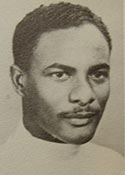 12 – On this day in 1950, Herman A. Barnett, III, an Austin native, enrolled as a regular student of the University of Texas Medical Branch in Galveston becoming the school’s first black student. However, in the previous year, Barnett had been accepted to the school but as a student in Houston at Texas State University for Negroes (now Texas Southern University), attending UTMB under a contract program between the schools. The program was stopped after the Veterans Administration (Barnett’s tuition was covered by the GI Bill) refused to recognize the contract system and Barnett’s attorney threatened legal action. Barnett became a prominent surgeon and anesthesiologist and was a graduate of Huston College (now Huston-Tillotson University) in Austin. During WWII, he was a Tuskegee Airman (332nd Fighter Group) and in 1968, became the first African-American to serve on the Texas State Board of Medical Examiners. In 1973, he was the first black elected president of the Board of Trustees of the Houston Independent School District.
12 – On this day in 1950, Herman A. Barnett, III, an Austin native, enrolled as a regular student of the University of Texas Medical Branch in Galveston becoming the school’s first black student. However, in the previous year, Barnett had been accepted to the school but as a student in Houston at Texas State University for Negroes (now Texas Southern University), attending UTMB under a contract program between the schools. The program was stopped after the Veterans Administration (Barnett’s tuition was covered by the GI Bill) refused to recognize the contract system and Barnett’s attorney threatened legal action. Barnett became a prominent surgeon and anesthesiologist and was a graduate of Huston College (now Huston-Tillotson University) in Austin. During WWII, he was a Tuskegee Airman (332nd Fighter Group) and in 1968, became the first African-American to serve on the Texas State Board of Medical Examiners. In 1973, he was the first black elected president of the Board of Trustees of the Houston Independent School District.
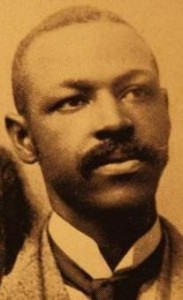 12 – Physician Monroe Alpheus Majors was born on this day in 1864 in Waco. Majors was also a civil rights leader and writer. He attended Tillotson College (now Huston-Tillotson University) in Austin, but graduated from Central Tennessee College in Nashville then enrolled at Meharry Medical College and graduated as salutatorian of his class in 1886. He was one of the founders of the Lone Star State Medical, Dental, and Pharmaceutical Association, one of the first medical societies in the country for black physicians. In 1888, fearing for his life after racist threats because of his influence in the community, he moved to Los Angeles and became the first black physician to practice medicine west of the Rocky Mountains. He returned to Waco in 1890 to practice medicine and serve as lecturer in hygiene and sanitation at Paul Quinn College, and also built and operated a hospital for blacks. As a writer, he published Noted Negro Women (1893), a book of biographies of prominent black women of the period, and in 1921 wrote First Steps and Nursery Rhymes, the first book of nursery rhymes written specifically for black children.
12 – Physician Monroe Alpheus Majors was born on this day in 1864 in Waco. Majors was also a civil rights leader and writer. He attended Tillotson College (now Huston-Tillotson University) in Austin, but graduated from Central Tennessee College in Nashville then enrolled at Meharry Medical College and graduated as salutatorian of his class in 1886. He was one of the founders of the Lone Star State Medical, Dental, and Pharmaceutical Association, one of the first medical societies in the country for black physicians. In 1888, fearing for his life after racist threats because of his influence in the community, he moved to Los Angeles and became the first black physician to practice medicine west of the Rocky Mountains. He returned to Waco in 1890 to practice medicine and serve as lecturer in hygiene and sanitation at Paul Quinn College, and also built and operated a hospital for blacks. As a writer, he published Noted Negro Women (1893), a book of biographies of prominent black women of the period, and in 1921 wrote First Steps and Nursery Rhymes, the first book of nursery rhymes written specifically for black children.
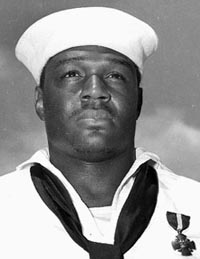 12 – On this day in 1919, Pearl Harbor hero Dorie (Doris) Miller was born in Waco. Miller was a mess man aboard the USS West Virginia when the Japanese attacked on Dec. 7, 1941. Miller moved several wounded sailors to safety and then manned an anti-aircraft gun, for which he had no training, and fired at attacking planes. For his actions, Miller was the first African-American to be awarded the Navy’s second highest honor, the Navy Cross.
12 – On this day in 1919, Pearl Harbor hero Dorie (Doris) Miller was born in Waco. Miller was a mess man aboard the USS West Virginia when the Japanese attacked on Dec. 7, 1941. Miller moved several wounded sailors to safety and then manned an anti-aircraft gun, for which he had no training, and fired at attacking planes. For his actions, Miller was the first African-American to be awarded the Navy’s second highest honor, the Navy Cross.
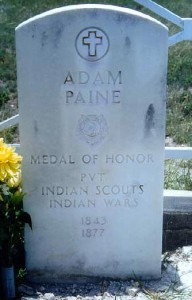 13 – In 1875, on this day, Adam (or, “Adan”) Paine (1843-1877), a black Seminole, was awarded the Congressional Medal of Honor. Paine was a scout at Fort Duncan, Texas, and received the MOH for his actions during a battle at Quitaque Peak where he defended himself and four other scouts against several bands of Comanche Indians on September 26, 1874. Greatly outnumbered, the scouts fled, fighting as they went, though Paine held back to protect the others, allowing them to get away as he fired repeatedly at their pursuers. Payne’s horse was shot from under him, however, Paine continued to fight and eventually shot the rider of one horse, mounted the animal and made his escape. Thanks to his efforts during the engagement, all of the scouts survived. Paine’s commanding officer, Colonel Ranald S. Mackenzie, said that Paine “has more cool (and) daring than any scout I have ever known.”
13 – In 1875, on this day, Adam (or, “Adan”) Paine (1843-1877), a black Seminole, was awarded the Congressional Medal of Honor. Paine was a scout at Fort Duncan, Texas, and received the MOH for his actions during a battle at Quitaque Peak where he defended himself and four other scouts against several bands of Comanche Indians on September 26, 1874. Greatly outnumbered, the scouts fled, fighting as they went, though Paine held back to protect the others, allowing them to get away as he fired repeatedly at their pursuers. Payne’s horse was shot from under him, however, Paine continued to fight and eventually shot the rider of one horse, mounted the animal and made his escape. Thanks to his efforts during the engagement, all of the scouts survived. Paine’s commanding officer, Colonel Ranald S. Mackenzie, said that Paine “has more cool (and) daring than any scout I have ever known.”
13 – On this day in 1864 the Elm Creek Raid occurred, during which a band of several hundred Kiowa and Comanche Indians raided a settlement in the Elm Creek Valley (northwest of Dallas and South of Wichita Falls) where Britt Johnson, a ranch foreman and former slave, and his family lived. During the raid, Johnson’s son, Jubal, was among several settlers killed. Johnson’s wife, Mary, and two daughters were among the hostages taken into Indian Territory (Oklahoma). Johnson spent the next year traveling into the Territory and finally locating his family. Johnson worked with Comanche Chief Asa-Havey to pay a ransom and regain his family. The story of Johnson’s quest (fact or fiction) was the inspiration for Alan LeMay’s 1954 novel, The Searchers, which director John Ford would turn into a movie of the same name in 1956 starring John Wayne.
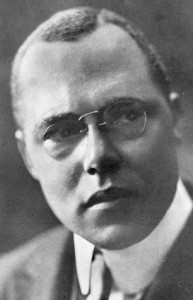 15 – Houstonian Emmett Scott was appointed Special Assistant to the Secretary of War, Newton Baker, on this day in 1917 as a liaison between black soldiers and the War Department amid rising racial tensions in the country. Among Scott’s accomplishments in that role were:
15 – Houstonian Emmett Scott was appointed Special Assistant to the Secretary of War, Newton Baker, on this day in 1917 as a liaison between black soldiers and the War Department amid rising racial tensions in the country. Among Scott’s accomplishments in that role were:
- The formation of a Speakers’ Bureau, or “Committee of One Hundred,” to enlighten black Americans on the war aims of the government.
- The continuance of training camps for black officers and the increase in their number and increasing their scope of training.
- Betterment of the general conditions in the camps where blacks were stationed in large numbers, and positive steps to reduce friction between
races. - The opening of every branch of the military service to colored men, on equal terms with all others, and the commissioning of many colored men as
officers in the Medical Corps. - A report about conditions facing African-Americans during the period, which were published in 1919 as The American Negro in the World War.
Blog: Ron Goodwin, author, PVAMU history professor
 Ron Goodwin’s bi-weekly blog appears exclusively for TIPHC/TBHPP. Goodwin is a San Antonio native and Air Force veteran. Generally, his column will address contemporary issues in the black community and how they relate to black history. He and the TIPHC/TBHPP staff welcome your comments. His latest blog is, “A change has come?” Read it
Ron Goodwin’s bi-weekly blog appears exclusively for TIPHC/TBHPP. Goodwin is a San Antonio native and Air Force veteran. Generally, his column will address contemporary issues in the black community and how they relate to black history. He and the TIPHC/TBHPP staff welcome your comments. His latest blog is, “A change has come?” Read it
Submissions Wanted
Historians, scholars, students, lend us your…writings. Help us produce the most comprehensive documentation ever undertaken for the African American experience in Texas. We encourage you to contribute items about people, places, events, issues, politics/legislation, sports, entertainment, religion, etc., as general entries or essays. Our documentation is wide-ranging and diverse, and you may research and write about the subject of your interest or, to start, please consult our list of suggested biographical entries and see submission guidelines. However, all topics must be approved by TIPHC/TBHPP editors before beginning your research/writing.
We welcome your questions or comments via email or telephone – mdhurd@pvamu.edu.
